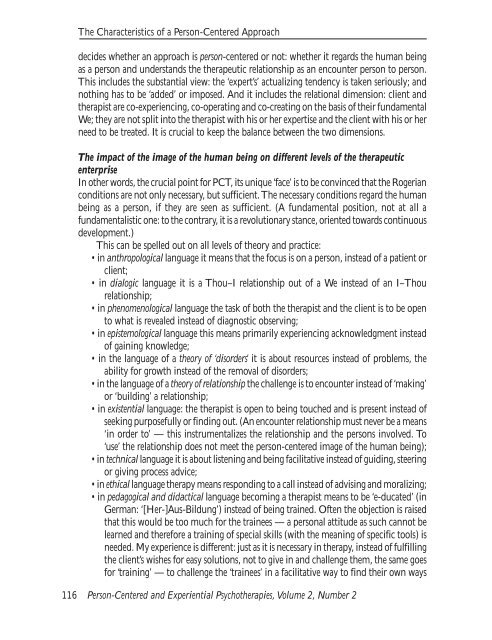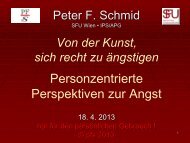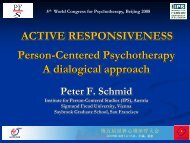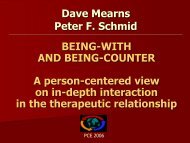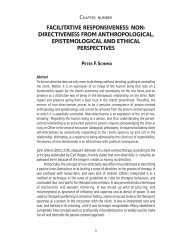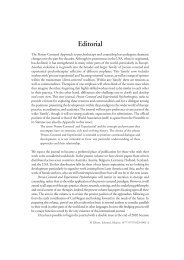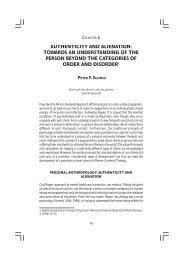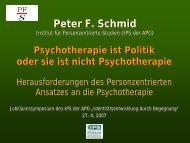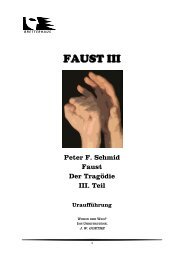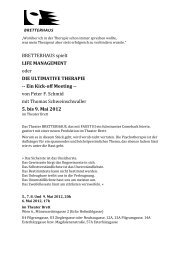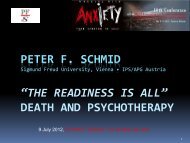The Characteristics of a Person-Centered ... - Peter F. Schmid
The Characteristics of a Person-Centered ... - Peter F. Schmid
The Characteristics of a Person-Centered ... - Peter F. Schmid
- No tags were found...
Create successful ePaper yourself
Turn your PDF publications into a flip-book with our unique Google optimized e-Paper software.
<strong>The</strong> <strong>Characteristics</strong> <strong>of</strong> a <strong>Person</strong>-<strong>Centered</strong> Approachdecides whether an approach is person-centered or not: whether it regards the human beingas a person and understands the therapeutic relationship as an encounter person to person.This includes the substantial view: the ‘expert’s’ actualizing tendency is taken seriously; andnothing has to be ‘added’ or imposed. And it includes the relational dimension: client andtherapist are co-experiencing, co-operating and co-creating on the basis <strong>of</strong> their fundamentalWe; they are not split into the therapist with his or her expertise and the client with his or herneed to be treated. It is crucial to keep the balance between the two dimensions.<strong>The</strong> impact <strong>of</strong> the image <strong>of</strong> the human being on different levels <strong>of</strong> the therapeuticenterpriseIn other words, the crucial point for PCT, its unique ‘face’ is to be convinced that the Rogerianconditions are not only necessary, but sufficient. <strong>The</strong> necessary conditions regard the humanbeing as a person, if they are seen as sufficient. (A fundamental position, not at all afundamentalistic one: to the contrary, it is a revolutionary stance, oriented towards continuousdevelopment.)This can be spelled out on all levels <strong>of</strong> theory and practice:• in anthropological language it means that the focus is on a person, instead <strong>of</strong> a patient orclient;• in dialogic language it is a Thou–I relationship out <strong>of</strong> a We instead <strong>of</strong> an I–Thourelationship;• in phenomenological language the task <strong>of</strong> both the therapist and the client is to be opento what is revealed instead <strong>of</strong> diagnostic observing;• in epistemological language this means primarily experiencing acknowledgment instead<strong>of</strong> gaining knowledge;• in the language <strong>of</strong> a theory <strong>of</strong> ‘disorders’ it is about resources instead <strong>of</strong> problems, theability for growth instead <strong>of</strong> the removal <strong>of</strong> disorders;• in the language <strong>of</strong> a theory <strong>of</strong> relationship the challenge is to encounter instead <strong>of</strong> ‘making’or ‘building’ a relationship;• in existential language: the therapist is open to being touched and is present instead <strong>of</strong>seeking purposefully or finding out. (An encounter relationship must never be a means‘in order to’ — this instrumentalizes the relationship and the persons involved. To‘use’ the relationship does not meet the person-centered image <strong>of</strong> the human being);• in technical language it is about listening and being facilitative instead <strong>of</strong> guiding, steeringor giving process advice;• in ethical language therapy means responding to a call instead <strong>of</strong> advising and moralizing;• in pedagogical and didactical language becoming a therapist means to be ‘e-ducated’ (inGerman: ‘[Her-]Aus-Bildung’) instead <strong>of</strong> being trained. Often the objection is raisedthat this would be too much for the trainees — a personal attitude as such cannot belearned and therefore a training <strong>of</strong> special skills (with the meaning <strong>of</strong> specific tools) isneeded. My experience is different: just as it is necessary in therapy, instead <strong>of</strong> fulfillingthe client’s wishes for easy solutions, not to give in and challenge them, the same goesfor ‘training’ — to challenge the ‘trainees’ in a facilitative way to find their own ways116 <strong>Person</strong>-<strong>Centered</strong> and Experiential Psychotherapies, Volume 2, Number 2


